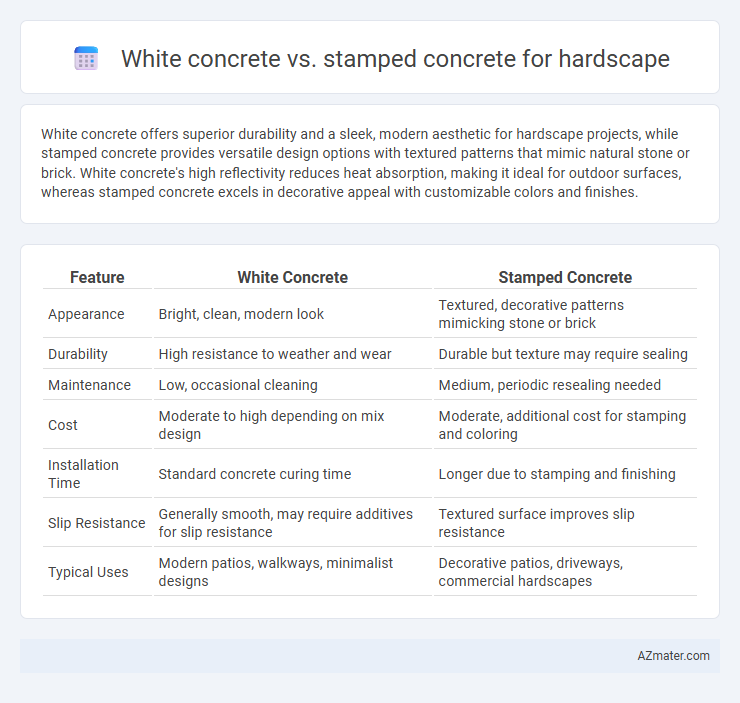White concrete offers superior durability and a sleek, modern aesthetic for hardscape projects, while stamped concrete provides versatile design options with textured patterns that mimic natural stone or brick. White concrete's high reflectivity reduces heat absorption, making it ideal for outdoor surfaces, whereas stamped concrete excels in decorative appeal with customizable colors and finishes.
Table of Comparison
| Feature | White Concrete | Stamped Concrete |
|---|---|---|
| Appearance | Bright, clean, modern look | Textured, decorative patterns mimicking stone or brick |
| Durability | High resistance to weather and wear | Durable but texture may require sealing |
| Maintenance | Low, occasional cleaning | Medium, periodic resealing needed |
| Cost | Moderate to high depending on mix design | Moderate, additional cost for stamping and coloring |
| Installation Time | Standard concrete curing time | Longer due to stamping and finishing |
| Slip Resistance | Generally smooth, may require additives for slip resistance | Textured surface improves slip resistance |
| Typical Uses | Modern patios, walkways, minimalist designs | Decorative patios, driveways, commercial hardscapes |
Introduction to White Concrete and Stamped Concrete
White concrete features a blend of white cement and light-colored aggregates, providing a clean, bright finish that enhances modern hardscape designs. Stamped concrete mimics the appearance of natural materials such as stone, brick, or wood through textured patterns and color overlays, offering versatile aesthetic appeal. Both options deliver durable surfaces suited for patios, walkways, and driveways, with white concrete emphasizing sleek minimalism and stamped concrete offering intricate visual interest.
Aesthetic Differences: Visual Appeal and Design Flexibility
White concrete offers a clean, modern aesthetic with a smooth, bright surface that enhances natural light and provides a timeless backdrop for various landscaping elements. Stamped concrete mimics natural materials like stone, brick, or wood, delivering intricate patterns and textures for a more decorative and customizable hardscape appearance. Design flexibility in white concrete emphasizes minimalism and elegance, while stamped concrete excels in creating detailed, visually dynamic surfaces tailored to diverse architectural styles.
Durability and Longevity in Outdoor Applications
White concrete offers superior durability and resistance to weathering, making it ideal for long-lasting hardscape projects exposed to harsh outdoor conditions. Stamped concrete provides aesthetic appeal with textured patterns but may require more frequent maintenance and sealing to preserve its integrity against wear and UV damage. Both materials withstand heavy foot traffic well, yet white concrete generally surpasses stamped concrete in longevity due to its uniform composition and lower susceptibility to surface deterioration.
Installation Process and Time Requirements
White concrete installation involves precise mixing and coloration to achieve a uniform bright finish, requiring skilled labor to avoid discoloration and surface defects; curing typically takes 7 to 14 days for optimal strength and whiteness. Stamped concrete requires pouring a base slab followed by imprinting textured molds while the concrete is still plastic, with a drying period of around 24 to 48 hours before sealers are applied to protect the patterns and enhance durability. The overall time for stamped concrete is generally shorter than white concrete, but both depend heavily on weather conditions and substrate preparation.
Cost Comparison: Initial and Long-Term Expenses
White concrete typically incurs higher initial costs due to specialized materials and pigmentation processes, while stamped concrete offers a more affordable entry price with versatile design options. Long-term expenses favor white concrete as its durability and resistance to fading reduce maintenance and repair needs compared to stamped concrete, which may require periodic resealing and patching to preserve aesthetics. Evaluating the total cost of ownership reveals white concrete's upfront premium balances with lower lifecycle expenditures, whereas stamped concrete's cost efficiency is stronger in short-term projects.
Maintenance Needs and Surface Upkeep
White concrete requires minimal maintenance, typically needing regular cleaning to prevent staining and occasional resealing to maintain its bright appearance. Stamped concrete demands more frequent upkeep, including sealing every 2-3 years to protect the patterned surface from wear and discoloration. While both surfaces benefit from proper cleaning, stamped concrete's textured design is more prone to trapping dirt and moisture, necessitating more intensive maintenance efforts.
Slip Resistance and Safety Considerations
White concrete offers a smooth finish with moderate slip resistance, often enhanced by adding anti-slip coatings or additives to improve safety on wet surfaces. Stamped concrete provides textured patterns that naturally increase traction, making it more slip-resistant and suitable for high-traffic outdoor areas. Selecting between the two for hardscape projects should consider specific safety needs, weather conditions, and maintenance practices to ensure optimal slip resistance and prevent accidents.
Environmental Impact and Sustainability Factors
White concrete offers lower heat absorption and improved reflectivity, reducing urban heat island effects and promoting energy savings in hardscape applications. Stamped concrete, while offering aesthetic versatility, often requires sealants and dyes that may introduce volatile organic compounds (VOCs), impacting environmental quality. Choosing white concrete aligns better with sustainable hardscape practices by enhancing durability and reducing maintenance-related emissions.
Best Uses: Ideal Hardscape Applications
White concrete is highly favored for modern driveways, patios, and walkways due to its bright, clean appearance and ability to reflect heat, making it ideal for hot climates. Stamped concrete excels in decorative applications such as pool decks, garden paths, and outdoor living spaces, offering versatile patterns and textures that mimic natural stone or brick. Both materials provide durable hardscape solutions, with white concrete emphasizing minimalistic design and stamped concrete enhancing aesthetic customization.
Choosing the Right Option for Your Project
White concrete offers a clean, modern aesthetic with high reflectivity, making it ideal for projects requiring bright, heat-reducing surfaces, while stamped concrete provides versatile design options that mimic natural materials like stone or brick, enhancing visual appeal with textured patterns. Consider project goals: white concrete suits minimalist, durable hardscapes such as driveways and commercial walkways, whereas stamped concrete excels in decorative patios and garden paths requiring customization and artistic detail. Evaluate factors like budget, maintenance, climate resistance, and desired style to choose the most suitable hardscape material for long-lasting performance and visual impact.

Infographic: White concrete vs Stamped concrete for Hardscape
 azmater.com
azmater.com